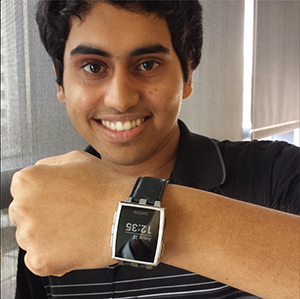The Best of Times: Student Tech Guru Sounds Off On Smartwatch Influx
Startup Co-founder and ELLC Mentor Nigel Coelho says the future of wearable tech is worth watching.
September 25, 2014
by Nigel Coelho | Co-founder, Kompact
The race for the wrist has been topic of speculation for the majority 2014. Tech giants have been teasing consumers with new product releases — each more revolutionary than the last. This summer, we saw the release of Motorola’s MOTO 360 and the Apple Watch. Although several long-time players, like the Samsung Gear S and the Pebble smartwatch, have been out for quite a while, this summer proved to be quite a surprise: a showcase of thoughtful designs and sleek finishes from two manufacturers able to design an amazing product, each fully aware of their respective limitations.
Let’s take a look at the key differences in each and pick out some key insights.
Apple Watch
The Apple Watch, with its intuitive user interface and luxurious look, sure didn’t disappoint. The design was further augmented with the scroll wheel. Apple knew its popular zooming feature could not be mimicked on a small LCD display. Hence, navigating through the user interface using a scroll wheel was a stroke of genius. Apple also trumped the competition with its health monitoring integration — something you can expect other smartwatch brands to mimic moving forward. Health monitoring is the next frontier of wearable tech, as industry giants like Google ramp up their efforts by bolstering the medical talent on their staffs.
The Apple Watch is a battery drainer with a daily charge cycle demand, but the user interface and design make it well worth the effort.
 Pebble
Pebble
The latest smartwatch releases left some big shoes to fill for the long-time smartwatch manufacturer. Despite its efficient e-reader technology — similar to the ones used by the Amazon Kindle — the Pebble watch is limited to a monochrome shade that helps for easy viewing in sunlight, but lacks the aesthetic of an LCD monitor. This difference also dictates battery life consumption and explains why a single charge on a Pebble can last for several days. However, even with the lack of voice recognition, Pebble’s simplistic design lends itself to the easy consumption of media, rather than actually inputting data. It does this by allowing notifications from your smartphone home screen to be displayed on the smartwatch. While it’s considered rude to check your phone while talking to someone, it is completely acceptable to check the time (in this case a notification on your smartwatch).
Despite fierce competition from the tech giants, Pebble’s value lies in the fact that it can be integrated with both iOS and Android operating systems. With Android platforms quickly penetrating a majority of the market, there is something to be said about Android wear. One of them being the MOTO 360.
MOTO 360
With its MOTO 360, Motorola did a very good job of producing a sleek watch with the grandeur of a classic, round watch face. The distinct round shape was intentionally designed by Motorola to optimize for user comfort, allowing for the wearer’s wrist to move more freely. However, this round design causes certain limitations, namely the difficulty of inputting data. Adapting a QWERTY keyboard to a round watch face is certainly possible, but not pragmatic. The errors caused when typing would have to be augmented by an accurate autocorrect library. Motorola did quite a good job of accounting for this by giving the user voice interaction using Google Now.
The Future of Wearable Tech
We are seeing an interesting paradox: In the age of smartphones of increasing screen size, the smartwatch market is going in the opposite direction, keeping screen sizes consistent or even smaller so as not to appear clunky on the wrist.
The real challenge will be user input coupled with a limiting screen size, leaving users fraught with frustration. A conventional QWERTY keyboard on a small screen just doesn’t cut it.
I believe that the future of smart watch inputs will include voice commands through artificial intelligence systems like Siri or Google Now. Platforms for processing verbal commands with extensive autocorrect libraries have already been released for developers to integrate with their applications. We will also see more compact and versatile keyboards with a dexterous autocorrect functionality. Minuum is a company that is already tackling this and has seen this problem coming for years.
We are transitioning into an era of the “internet of things.” From smart refrigerators that track your food to “smarty pants” that track your running activity, the future of wearable technology is ripe for disruption.